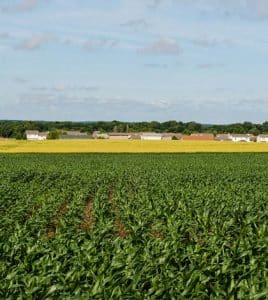Farmers feeling optimistic about this year’s crops

Two-thirds of the panorama of Monroe County field crops is seen here, with corn, planted this spring, emerging dark green in the foreground, and winter wheat, planted last fall, turning from green to light green and then yellow beyond it.
There are a large number of “optimists” in action across Monroe County and adjacent areas.
We’re not talking about members of the civic organization that promotes youth and community development. We’re talking about farmers, who grow acres of crops that dominate our economy and lives.
You must be an optimist to ride the year-in, year-out cycle of planting, nurturing, harvesting, marketing, and then starting all over again.
Local farmers are upbeat about possible crop yields in store this year.
Three major crops grown here are wheat, corn and soybeans. They are not grown to the exclusion of each other, but rather in a rotation that sees different crops follow each other in a given field – grain, like corn or wheat, followed by beans – and then a grain again.
The wheat you see emerging and ripening this spring was planted last fall. It is called “winter wheat” and actually emerged during the winter months, taking off as soon as temperatures started to warm. It grows as a green crop, with tiny flowers on a slander stem. Kernels form as it reaches maturity. And now it is starting to turn yellow, moving toward bright yellow and then brown, as it matures and dries for harvest in coming weeks.
Delbert Wittenauer expressed cautious optimism about his wheat crop.
“This could be another good wheat crop, yield-wise,” he said.
Wittenauer added that it remains to be seen whether rust or scab diseases may appear, a caution another county farmer echoed.
Justin Scheibe said weather in the next couple of weeks will strongly influence both possible disease emergence and what is termed test weight – the actual amount of food product in each wheat kernel. Timing is critical.
“We have to get the combines into the fields to harvest the wheat before it rains too much,” Wittenauer said.
Both farmers said all they can do is wait. They have sprayed to curtail diseases, and what is going to happen will inevitably happen now.
Gateway FS crop specialist Matt Keller agreed.
“We have seen some disease in wheat this spring,” he said. “In two or three weeks, we’ll know how it will turn out.”
Wittenauer was also an early planter of corn this spring.
“The soil has to warm to 50 degrees before you can plant corn,” he said. “I was surprised to find it at 55 up on the bluff early this spring. So I said, ‘Why not?’”
He planted corn on March 24 – the earliest he has ever planted.
Following the recent chilly, so-called “blackberry winter,” he noted that soil temperatures had dropped to 53 degrees.
“But it is off and growing,” he affirmed.
Scheibe said he planted about two weeks after Wittenauer put corn in the ground.
Corn likes heat and sun, but an adequate supply of moisture is important, too. It takes up moisture and “exhales” it, and one-quarter inch of rain per day during greatest growth is optimal.
Wittenauer described the process as “breathing and sweating.” If there’s not adequate rain, corn will slow, then stop and wilt. It may not recover – as happened several summers ago.
Finally, soybeans round out the local major crop rotation. They will be planted twice this summer. Some have been planted only recently, or are even going into the ground now. They are often going into fields that hosted corn last fall.
Scheibe said he planted 200 acres May 4-6.
“I may need to replant five to 10 of those acres,” he said, due to wet conditions. “But they look very good right now.”
A second planting of beans will occur in the fields where wheat will soon be harvested. They in turn, will be harvested later this fall.
One area of Monroe County is strongly influenced by its geography. That is the so-called bottoms, or former floodplain along the Mississippi River. There, fields that once flooded almost every year are protected to a point by agricultural elevation and strength levees.
The soil is rich and productive, but the threat of flooding is present virtually every year. While spring and summer are traditional flood seasons, there was unusual, extensive flooding in the bottoms in late December into January.
The same river that offers lowest cost transportation to move agricultural commodities to export markets can also damage or destroy those farm outputs before they can grow.
Wittenauer confirmed that while flooding did cause problems in the bottoms during the winter, “the Mississippi River is behaving well now. Hopefully we have seen its worst for this year.”
Of course, one important element still remains to be seen. How much will the crops bring once harvested and brought to market? Supply and demand, which is influenced by conditions worldwide, plays a role.
But that’s just one of many factors.
What we do know for sure, though, is Monroe County’s farmer “optimists” are part of the Midwestern bread basket that feeds our nation and much of the rest of the world. The synergy between good farming practices, good location and weather, and a smoothly operating transportation system of trucks, trains and barges move the output to market.
And that synergistic team, in turn, drives our economy.
Farmers toil all summer long. They will plant, weed, fertilize, fix farm machines and perform a million other tasks that are part of their daily lives.
And then, farmers will plant again. They are optimists, after all.








